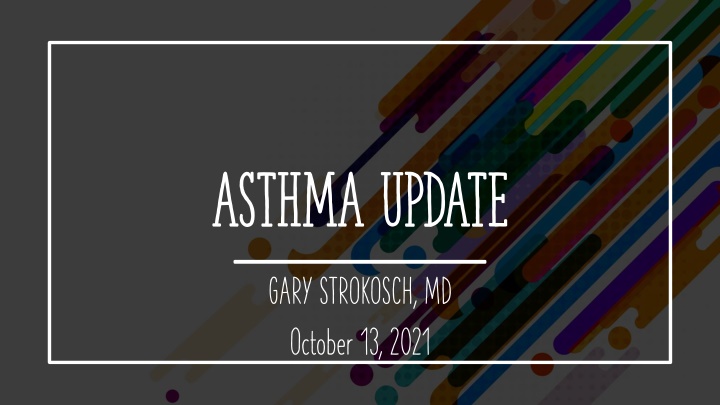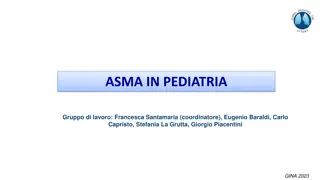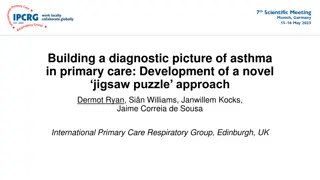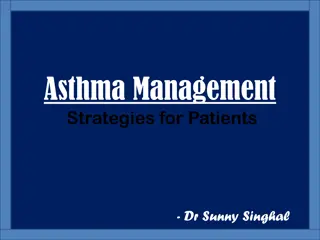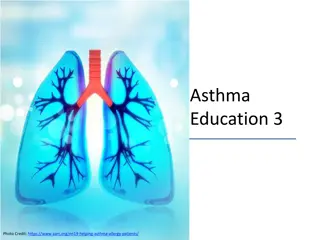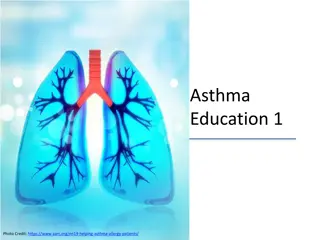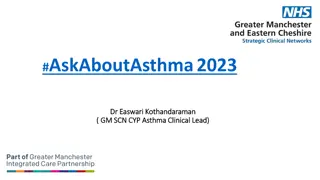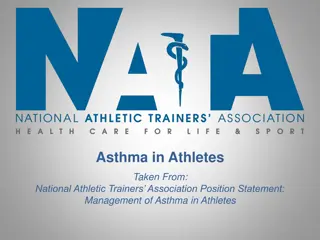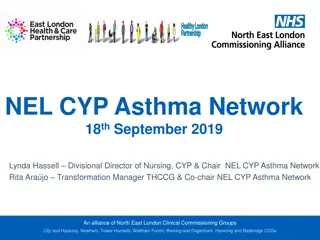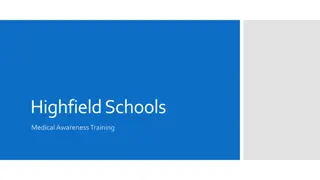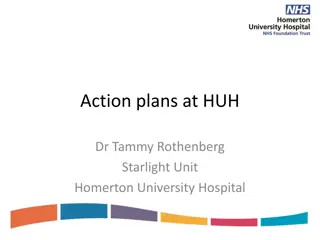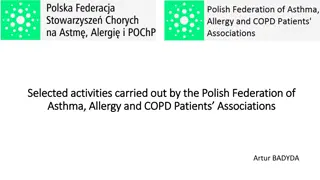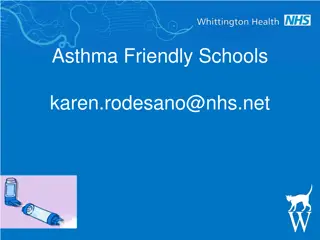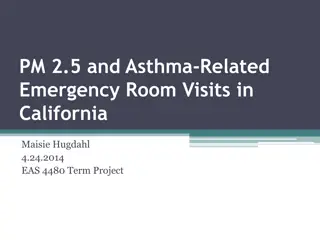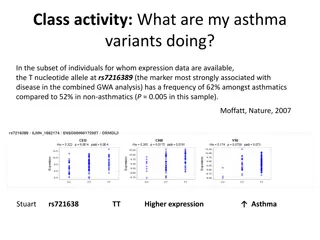ASTHMA UPDATE
Asthma is a chronic respiratory condition affecting millions of Americans, with a higher impact on Black Americans. While there is no cure, proper education, trigger avoidance, medication management, and preparedness can aid in controlling asthma symptoms and reducing mortality rates. National guidelines and healthcare protocols play a vital role in ensuring effective treatment and care for individuals with asthma.
Download Presentation

Please find below an Image/Link to download the presentation.
The content on the website is provided AS IS for your information and personal use only. It may not be sold, licensed, or shared on other websites without obtaining consent from the author.If you encounter any issues during the download, it is possible that the publisher has removed the file from their server.
You are allowed to download the files provided on this website for personal or commercial use, subject to the condition that they are used lawfully. All files are the property of their respective owners.
The content on the website is provided AS IS for your information and personal use only. It may not be sold, licensed, or shared on other websites without obtaining consent from the author.
E N D
Presentation Transcript
ASTHMA UPDATE GARY STROKOSCH, MD October 13, 2021
ASTHMA OVERVIEW Asthma affects more than 25 million Americans: About 1 in 13 Americans 8% of adults and 7% of children More women than men / more boys than girls In 2018 asthma accounted for 178,530 hospital discharges and 1.6 million ED visits Black Americans are 5 times more likely than whites to visit the ED for asthma
ASTHMA OVERVIEW 3,524 people died from asthma in 2019, many deaths were avoidable with proper treatment and care Black Americans are nearly 3 times more likely to die from asthma that whites
ASTHMA OVERVIEW There is no cure for asthma !!! It is a chronic disease that causes airways to become inflamed, making it hard to breathe
ASTHMA OVERVIEW Education, education and education The next best way to manage asthma: is to avoid known triggers, take medications to prevent symptoms and prepare to treat asthma episodes if they occur.
Job Corps Chronic Care Management Plan ASTHMA: A FACT SHEET FOR STUDENTS TOPICS What is asthma? Overview Outlook Asthma is one of 23 fact sheets found at: Figure A shows the location of the lungs and airways in the body. Figure B shows a cross-section of a normal airway. Figure C shows a cross-section of an airway during asthma symptoms. https://supportservices.jobcorps.gov/ health/Documents/CCMPs/FactSheets/ AsthmaFactSheet.docx 2014
JOB CORPS HEALTHCARE GUIDELINES (HCGs) SYMPTOMATIC MANAGEMENT GUIDELINES (SMGs) Medial - 26 (including asthma) Mental Health - 3 TEAP/TUPP - 2 Oral Health - 3 TREATMENT GUIDELINES (TGs) Medical - 57 (including asthma) Mental Health - 8 TEAP/TUPP - 3 Oral Health - 4
NATIONAL GUIDELINES ASTHMA TREATMENT GUIDELINE Updated June 2020 This 2020 guideline is an update from July 2015 Guidelines from the National Asthma Education and Prevention Program (NAEPP) of the National Heart, Lung, and Blood Institute (NHLBI) were first published in 1991. Updates were published in 1997, 2002, 2007 and 2020.
JOB CORPS HEALTHCARE GUIDELINES ASTHMA SYMPTOMATIC MANAGEMENT GUIDELINE November 2019 SYMPTOMATIC MANAGEMENT GUIDELINES FOR NON-HEALTH STAFF ASTHMA Authorized non-health staff may manage asthma as follows: 1. Any student with severe wheezing, gasping, blue color or other signs of respiratory distress requires immediate medical attention. Call 911 for emergency transport. Offer the student oxygen by facemask if available. Albuterol HFA treatments (2 inhalations) may be offered to the student every 15-20 minutes while awaiting transport. 2. Any student with wheezing who does not respond within 10-15 minutes to two inhalations from an albuterol HFA should be referred immediately to the health and wellness center. 3. Students known to have asthma should have access to an albuterol HFA at all times on center. WHEN TO CONTACT THE ON-CALL HEALTH AND WELLNESS STAFF If the student s wheezing does not respond to two inhalations within 10-15 minutes from an albuterol HFA
ACUTE MANAGEMENT OF ASTHMA MILD-MODERATE BRONCHOSPASM ?? SEVERE BRONCHOSPASM
MILD-MODERATE BRONCHOSPASM In the absence of signs of severe respiratory distress needing immediate medical attention, students with asthma who experience acute mild to moderate bronchospasm should be instructed to initiate Rescue Therapy
MILD-MODERATE BRONCHOSPASM - Rescue Therapy - Administer inhalation of a short-acting 2-agonists (albuterol) at a dose of 2 to 4 puffs of 90 mcg (albuterol base) every 20 minutes.
SEVERE BRONCHOSPASM Obtain vital signs and pulse oximetry. Any student with severe wheezing, muscle retractions, gasping, blue color or other signs of respiratory distress requires immediate medical attention - call 911 for emergency transport. Administer oxygen by facemask if available. Initiate Rescue Therapy.
SEVERE BRONCHOSPASM Rescue Therapy Provide the Inhalation of a short-acting 2-agonists (albuterol): Administer a nebulizer solution with a concentration of 2.5 to 5 mg every 20 minutes for three cycles, --- or --- Have the student administer 4 to 8 puffs of 90 Mcg (albuterol base) every 20 minutes with a metered- dose inhaler.
CHRONIC MANAGEMENT OF ASTHMA Classify all students with asthma according to the NHLBI severity guidelines: Intermittent Mild Persistent Moderate Persistent Severe Persistent
INTERMITTENT ASTHMA Symptoms < 2 days a week Nighttime awakenings < 2 times a month Use of short-acting 2-agonist < 2 days a week No interference with physical activity
MILD PERSISTENT ASTHMA Symptoms > 2 days a week but not daily Nighttime awakenings 3-4 times a month Use of short-acting 2-agonist > 2 days a week, but not daily, and not more than once on any day Minor limitation of physical activity
MODERATE PERSISTENT ASTHMA Symptoms daily Nighttime awakenings > 1 time a week but not daily Use of short-acting 2-agonist daily Some limitation of physical activity
SEVERE PERSISENT ASTHMA Symptoms throughout the day Nighttime awakenings often 7 times a week Use of short-acting 2-agonist several times a day Extreme limitation of physical activity
TREATMENT OF ASTHMA Treat all students with asthma according to the NHLBI guidelines (however, 6 does not equal 4): Step 1 (intermittent asthma) Step 2 (mild persistent asthma) Step 3 (moderate persistent asthma) Step 4 (moderate-severe persistent asthma) Step 5 (severe persistent asthma) Step 6 (severe persistent asthma)
STEP 1 Rx (intermittent asthma) Daily medication is NOT needed As-needed short-acting 2-agonist (albuterol) for rescue therapy
STEP 2 Rx (mild persistent asthma) Daily low-dose inhaled corticosteroid and As-needed short-acting 2-agonist (albuterol) for rescue therapy - OR As-needed concomitant use of low-dose inhaled corticosteroid and short-acting 2-agonist (e.g., 2-4 puffs of albuterol immediately followed by 80-250 Mcg beclomethasone equivalent) every 4 hours
STEP 3 Rx (moderate persistent asthma) (SMART: Single Maintenance AND Rescue Therapy) Daily (1-2 puffs once to twice daily) and as needed (1-2 puffs every 4 hours) combination low-dose inhaled corticosteroids and long-acting 2-agonist (fomoterol) (to a maximum total daily maintenance and rescue dose of 12 puffs (54 Mcg)
STEP 4 Rx (moderate-severe persistent asthma) (SMART: Single Maintenance AND Rescue Therapy) Daily (1-2 puffs once to twice daily) and as-needed (1-2 puffs every 4 hours) combination medium-dose inhaled corticosteroids and long-acting 2-agonist agonists (fomoterol) (to a maximum total daily maintenance and rescue dose of 12 puffs (54 Mcg)
STEP 5 Rx (severe persistent asthma) Daily medium- to high-dose inhaled corticosteroids combined with long-acting 2-agonist (fomoterol) plus an add-on long-acting muscarinic antagonist As-needed short-acting 2-agonist (albuterol) for rescue therapy
STEP 6 Rx (severe persistent asthma) Daily high-dose inhaled corticosteroids combined with long- acting 2-agonist (fomoterol) PLUS oral corticosteroids As-needed short-acting 2-agonist (albuterol) for rescue therapy
JC ASTHMA TREATMENT GUIDELINE CONTINUED 3. At each visit monitor adherence to treatment plan, efficacy of the current treatment plan, inhaler use technique, environmental factors, and any comorbid conditions. 4. All students known to have asthma should have access to an albuterol inhaler at all times for Rescue Therapy on center and for off-center trips.
JC ASTHMA TREATMENT GUIDELINE CONTINUED 5.Increasing use of Rescue Therapy to > 2 days per week for symptom relief (not prevention of exercise-induced bronchoconstriction) generally indicates inadequate control and the need to step up treatment.
JC ASTHMA TREATMENT GUIDELINE CONTINUED 6. The differences of albuterol (ProAir, Ventolin and Proventil) compared to levalbuterol (Xopenex) for rescue are negligible. It is recommended to prime the rescue inhaler before using for the first time and in cases where the inhaler has not been used for more than 2 weeks by releasing four test sprays into the air. Also, it is important that the mouthpiece be washed and dried thoroughly at least once a week.
NOTE: CFC and HFC INHALERS CFC-propelled inhalers were no longer be available after December 31, 2008 due to their environmentally harmful effects on the ozone layer. The HFA propellant hydrofluoroalkane is stickier than the CFC propellant chlorofluorocarbons. The HFA propellant may build up where the metal canister meets the plastic case of the MDI. Several studies have shown that HFA MDIs deliver albuterol and other medications more effectively into the lung tissue than do CFC MDIs.
JC ASTHMA TREATMENT GUIDELINE CONTINUED 7. Formoterol is a long-acting 2 agonists but because it has a fast onset of action it can also be used as a rescue medication. Salmeterol causes bronchodilation in a slower manner. Both drugs are long-acting. 8. The combination of inhaled corticosteroids and a long- acting 2 agonists (fomoterol) is available and preferably used in a single inhaler.
JC ASTHMA TREATMENT GUIDELINE CONTINUED 9. Cromolyn, nedocromil, leukotriene receptor antagonists (zileuton and montelukast), and theophylline were not considered for the 2020 update; limited availability and increased need for monitoring side-effects make their use less desirable. The FDA issued a black-box warning for montelukast in March 2020 due to adverse serious behavior- and mood-related changes.
JC ASTHMA TREATMENT GUIDELINE CONTINUED 10. Consult with asthma specialist if Step 4 or higher is required. Step 1 (intermittent asthma) Step 2 (mild persistent asthma) Step 3 (moderate persistent asthma) Step 4 (moderate-severe persistent asthma) Step 5 (severe persistent asthma) Step 6 (severe persistent asthma)
EXERCISE-INDUCED ASTHMA Short-Acting 2-agonist (albuterol): Use 5 to 20 minutes (optimally 15) minutes before exercise. The bronchodilation is of rapid onset and can last 2 to 4 hours. Tolerance can develop with frequent use but are the preferred first-line treatment and have limited side effects.
JC ASTHMA TREATMENT GUIDELINE CONTINUED WHEN TO REFER TO THE CENTER PHYSICIAN If the student s wheezing does not respond within 10-15 minutes to 2-3 inhalations from an albuterol inhaler If the student presents with severe wheezing, muscle retractions, gasping, blue color or other signs of respiratory distress Students with increasing use ofshort-acting inhaled 2 agonists Students who require daily medication for asthma management should be seen at least monthly
I hope they dont ask me about all those asthma drugs.
REFERENCES JAMA 2020; 324(22): 2301-2317: Managing Asthma in Adolescents and Adults - 2020 Asthma Guideline Update From the NAEPP J Allergy Clin Immunol. 2020; 146: 1217-1270: Expert Panel Working Group of the NHLBI. Focused updates to the asthma management guidelines: a report from the NAEPP Coordinating Committee Expert Panel Working Group.
